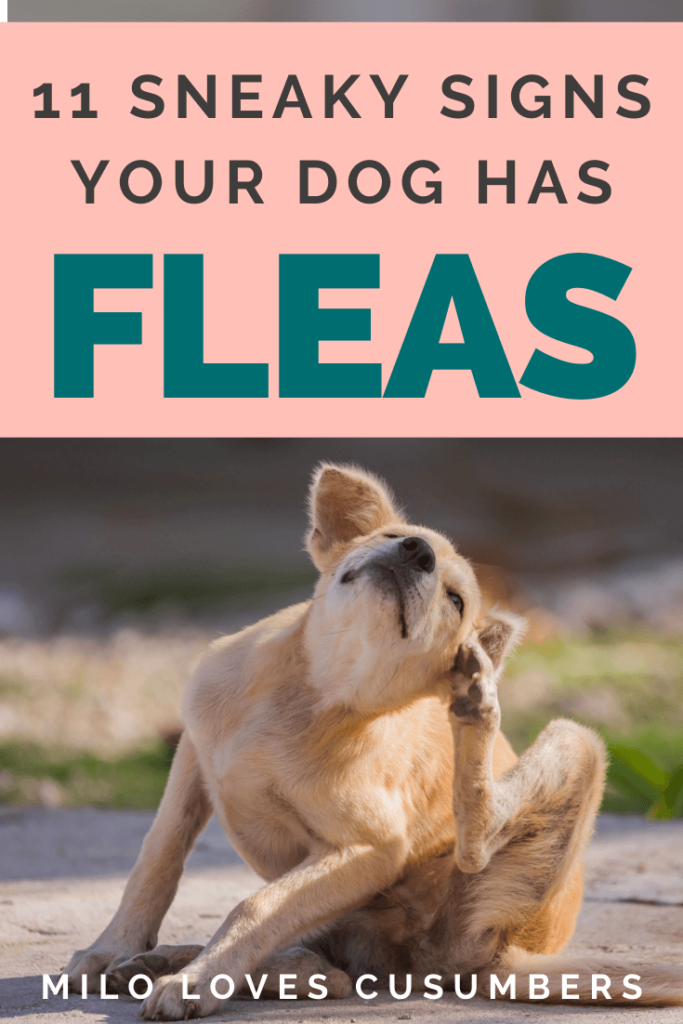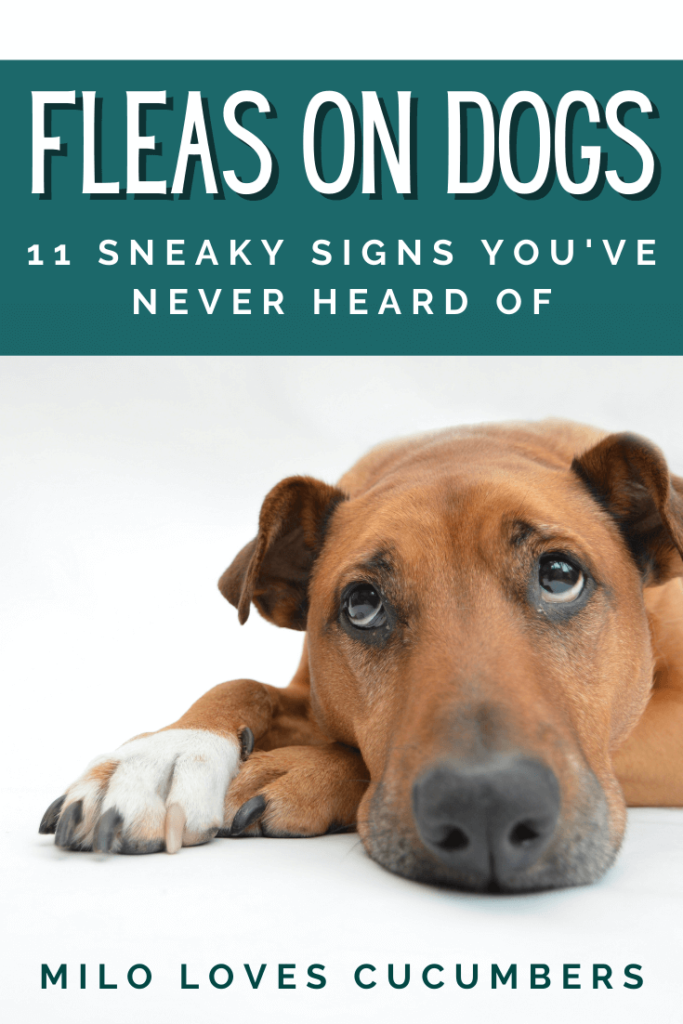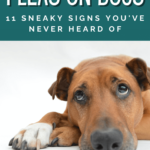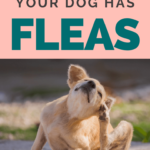Milo loves the outdoors and we spend a lot of time playing outside when the weather is nice. However, that means that fleas are always a concern – even though he gets his regular flea meds. So I make it my mission to check him for fleas every month – just in case. But this got me thinking about how easy it would be to miss any signs of fleas. So, I’ve put together some sneaky, but tell-tale signs your dog has fleas!
Signs of Fleas in Your Dog:
- Scratching, licking, and biting
- Red patches on the skin
- Flea eggs
- Tapeworms in your dog’s poop
- You have red bumps
- You can see flea dirt
- Sores on the skin
- Loss of fur
- Pale gums
- Restlessness
- Scabbing

Disclosure: This post may contain affiliate links. If you purchase a product through one of our affiliate links we make a small commission from the sale at no extra cost to our readers.
1) SCRATCHING, LICKING, AND BITING
While it’s normal for a pup to groom by licking their fur, skin, and paws, if the scratching, biting, and licking are more frequent and intense, your fur baby has likely been infected with fleas.
An infected dog usually whips around and licks and bites the area of irritation. Your pooch may also shake their head as though trying to shake the fleas off.
Fleas also love hiding behind the ears, which may cause your pooch to scratch them frequently.
Milo always grooms himself by licking his paws after we come back from outdoor playtime to clean the dirt off. And I make sure to pay attention, just in case.
When you notice your fur baby licking along their legs and abdomen it’s unusually a good indication that they might have fleas.
Fleas also love to hang out at the base of the tail, so if you see your dog biting and licking themselves there more than normal, it’s best to check for fleas!
2) RED PATCHES ON THE SKIN
Flea saliva is irritating to a dog. This is due to the protein in the saliva that causes an allergic reaction to some dogs.
Because of this, flea bites leave bumps on your pooch’s skin, usually at the back of the neck and on the base of your fur baby’s tail.
The fleas feed on blood from your furry friend, and when they bite, they can cause a condition known as allergic dermatitis.
If your pooch is hypersensitive to flea bites, their skin becomes itchy and develops red patches and bumps.
These red patches consistent with flea bites make your fur baby miserable because they are itchy and cause your pooch a lot of discomforts.
But don’t worry, getting rid of the creepy crawlies on your dog helps get them out of their misery, and also helps the patches and bumps disappear.
So if you notice these red bumps, it’s definitely a sign your dog has fleas!
3) FLEA EGGS
Fleas lay white, oval eggs on your dog that fall around the area where the pooch lies – places like the carpet, couch, and even your bed!
Adult fleas lay dozens of eggs on your pooch’s skin, 50% of which are likely to develop into full-blown adult fleas.
Eggs are commonly laid on the base of the tail, the neck, shoulder blades, and hindquarters. But you can find them anywhere on your pooch.
Flea eggs resemble salt granules and fall off the dog’s skin when you brush it, so if you notice anything like that, take a closer look!
To confirm that your four-legged bestie has flea eggs, place them on a dark sheet and gently brush their hair with a doggie brush.
You’ll see white, sand-like, oval granules fall off the fur.
It is easy to confuse flea eggs with dandruff, however.
The difference is that dandruff is flat and has no particular shape while flea eggs are oval-shaped and grainy.
So if you find any of these oval shaped eggs coming off your pup, it’s time to get out the flea shampoo!
Your fur baby probably has fleas.
4) TAPEWORMS IN YOUR DOG’S POOP
Fleas are also hosts to tapeworms that can infect your dog.
When dogs react to a flea bite, they may inadvertently swallow a flea that has ingested tapeworm larvae – as gross as that sounds!
In addition to other signs of flea infestation, when you see your pooch dragging their bottoms along the ground, they’re most likely infected with tapeworms and are trying to relieve the irritation.
The tapeworms grow in your canine’s intestines, and when they mature, segments of them are passed through when your pooch does their number two.
Inspecting your canine’s poop can give you an idea of what’s hiding in their gut.
And if you find tapeworms, they most likely have fleas hanging around as well!
The segments of tapeworm that are passed with stool contain eggs, and if your dog poop isn’t disposed of properly, the tapeworm eggs may be passed on to a new host.
Which is never good!
5) YOU HAVE RED BUMPS
If you suddenly become itchy and notice a few red bumps around your ankles, it’s time to check your baby for fleas!
Fleas are brown or dark reddish – but they are tiny little things, so you may never actually see them.
They also jump and it is easy to miss them, but if you see some tiny little bug jumping (up to a foot) around the house, it’s likely that the fleas have set up shop in your home and your pup isn’t the only victim!
Fleas like to set up shop on your fur baby, but as they continue to lay their eggs and multiple, they spread out looking for new things to feed off of.
That means that they make their home in your carpet, your linens, and anywhere else they can hide!
Then when you walk around your house, those fleas find their way onto their next victim – you!
Thankfully, people don’t have enough hair on their body for fleas to make a permanent home. But they do a great job of getting a few bites in before they move on!
So if you start itching, have red bumps, and notice any other signs your dog has fleas – it’s time for some immediate flea control!
6) YOU CAN SEE FLEA DIRT
Flea dirt is a brown or reddish powdery substance that your fur baby sheds when they’re infested with fleas – ick!
These tiny dark specks can be spotted around the dog bed, carpet, bedding, or anywhere your pooch likes to spend time.
Flea dirt is actually not dirt at all, though.
It’s the fleas’ fecal matter and the dark color is present due to the digestion of your fur baby’s blood.
Because fleas are hard to spot, the presence of flea dirt lets you know there are some unwelcome guests in your pet’s crib.
To confirm that what you see around your fur baby’s bed is no dust or other dark matter, dab the area with a wet paper towel. If the towel looks like it has a bloodstain on it, that’s certainly flea dirt.
Cleaning your pooch with anti-flea shampoo helps get rid of some of the flea dirt as well as the fleas.
But definitely give your pup’s belongings a good scrub down too!
7) RESTLESSNESS IN YOUR DOG
Imagine having dozens of crawling parasites that bite, suck, lay eggs, and even defecate on your skin.
That would drive you up the wall, right?
That’s how your pooch feels when these critters invade their skin day and night.
And because they have no way of communicating their distress, it shows in their behavioral patterns.
Your canine may become restless, grumpy, or exhibit odd behavior due to the discomfort they’re going through.
While some dogs are more allergic to flea bites and scratch non-stop, others are tolerant to itching, which makes it hard to figure out that they have a flea infestation.
This is where your dog’s behavior can speak volumes about their distress.
If your pooch is unusually cranky or restless, take a look and find out what’s causing this odd behavior!
8) SORES ON THE SKIN
Sores on humans are painful and we have been given the wisdom and the resources to take care of them.
I hate to imagine what our pups go through when they’re in pain.
Fleas bites cause your dog to itch, which causes them to scratch and bite on their skin to alleviate the itch.
The incessant scratching and gnawing on the affected areas make your pooch break its skin, which causes sores. And if left untreated, they can cause a bacterial infection!
Have your pooch sit or stand in front of you and check for any sores – especially in areas that they scratch frequently.
You can rub your dog gently to keep them calm and still, and when you’re done, offer them a treat as praise!
It took a while to get Milo to stay still when checking him out for fleas because he’s an outdoorsy baby and is always hyper, but I can always win him over with a good treat!
9) LOSS OF FUR
Whether your dog has lush fur that you can run your fingers through or is a short-haired pup like Milo, I’m sure we all agree that all our fur babies are adorable, especially with all their fur!
A flea infestation causes your dog to itch, which makes them scratch and bite frequently.
And all this scratching can actually cause your fur baby to lose hair in the affected areas!
The red patches and sores are also notorious for creating hair loss on your dog. If they are losing abnormally high volumes of fur, take them to the vet and have them checked out – ASAP!
The skin of your canine speaks volumes about their health – and fleas can cause a myriad of skin problems, which also causes loss of hair.
A vet can give you the right advice on how to treat and prevent more hair loss. But the good news is that in most cases, your dog’s hair will grow back once the fleas are gone!
10) PALE GUMS
Pale gums in your pup can be a sign of anemia – one of the sneaky signs your dog has fleas!
Red blood cells circulate oxygen in your dog’s body and if they don’t have enough, it results in anemia.
And your doggie’s blood is a delicacy to fleas.
So if the infestation is on a large scale, chances are those fleas are sucking your pup dry – leading to anemia!
Fleas also suck out blood on the coat for larvae to feed on, which causes your pup to lose more blood overall.
And just like in humans, the loss of too much blood can cause anemia in your pooch – and pale gums are a sign that your dog doesn’t have enough blood!
Severe anemia can be fatal to dogs, especially puppies, and you must take your pup to a veterinarian for treatment, which may involve a blood transfusion.
This usually is a sign of a serious flea problem, which will likely need veterinary assistance to heal.
So if you notice pale gums along with other signs your dog has fleas, don’t wait to seek medical attention for your pup!
11) SCABBING
Scabbing is the crusty part that occurs on a dog’s skin when a flea bite leaves a pimple on the skin.
Because the bite itches, your pooch gnaws on it and causes it to pop, which turns it into a sore.
When the sore is drying up, it creates a hard crust that covers it. That scab acts as a protective cover on a healing wound.
So while it’s completely normal for the scabbing to occur, it’s an indication that your dog may have fleas!
If you find major scabs on your dog, they may be having an allergic reaction to fleas, but the best thing to do is to take them to the vet for a proper examination.
Mild scabbing falls off on its own so don’t scratch it off or let your dog scratch at it. This could stir up the sore if it is not properly healed – which, if not taken care of, might cause a bacterial infection.
Using a doggie brush, gently brush the coat to remove any scabs that linger in the fur after they’ve fallen off. Just be careful not to brush too hard so you don’t peel the crusts that haven’t completely healed!
TIPS TO PREVENTING FLEAS ON YOUR DOG
To keep your house safe and flea free, it’s best to take preventive measures to keep pests out!
These tips can help keep fleas away from your dog:
- Keep your dog on flea medication – or a flea collar of some sort at all times. Especially if they love to spend time outdoors!
- Clean your cushions, pillows, bedding, and carpet at a high temperature. This kills fleas and their eggs.
- Use anti-flea doggie shampoo on your pooch. It helps kill the bugs and the eggs that might have been laid on their fur.
- Run a comb on your dog every so often to make sure there are no signs of infestation.
- Clean your dog’s bed and any other areas they like to spend time in on a regular basis.
- Keep your lawn short and manicured. It makes it hard for bugs to hide. An overgrown lawn is more likely to be home to fleas.
- Bathe your dog regularly to prevent bugs from nesting on their skin.
- Don’t leave dog bowls outside to prevent wild cats, ferrets, etc from invading your backyard and leaving bugs on your grass.
OTHER BUGS TO WATCH OUT FOR IN YOUR DOG
Fleas can cause you and your pooch a lot of stress. Because they jump, they don’t just settle on the dog’s skin. They can drink from you too. Unfortunately, besides fleas, your canine can be infected with other bugs.
Here is a list of some of the other creepy crawlies to watch out for on your pup!
- Bedbugs – Bed bugs are annoying and they smell bad. Your canine, just like you, can get bitten by bedbugs. If you find bedbugs around your dog’s bed or under their skin, call an exterminator ASAP!
- Ticks – If you’ve taken your pooch on a hike recently (especially in a wooded area) you should examine them for ticks. If ticks go unnoticed for a long time, they can cause more serious problems in your canine. I always vaccinate Milo for Lyme disease which is carried by ticks – just in case!
- Stinging insects – Some dogs are allergic to bee and wasp stings. Allergic reactions you may see include breathing difficulties, swelling, and seizures. If you suspect that your fur bestie is reacting to a sting, rush them to the emergency room!
- Lightning bugs – The glowing toxin fireflies carry can be poisonous. If your dog starts vomiting after ingesting lightning bugs, take them to the vet.
- Ants – When dogs stick their nose in an anthill, they won’t like what they find! They can get hundreds of bites in a very short time, and while they may not cause a serious reaction, there is a mild risk of an allergic reaction known as anaphylaxis.
- Mosquitoes – While not all mosquitoes are carriers of heartworm, if your furry friend gets bitten by one that is a carrier, it can have serious effects if it goes unnoticed.
When you are out and about with your furry friend, be on the lookout for these bugs. You may not catch all activity your dog is into but you can catch some and get them out of danger!
Your dog is your best companion, and you always know when things are not right with them. Watching out for these sneaky signs your dog has fleas can help you stop an infestation before it gets out of hand!
PIN IT FOR LATER!




